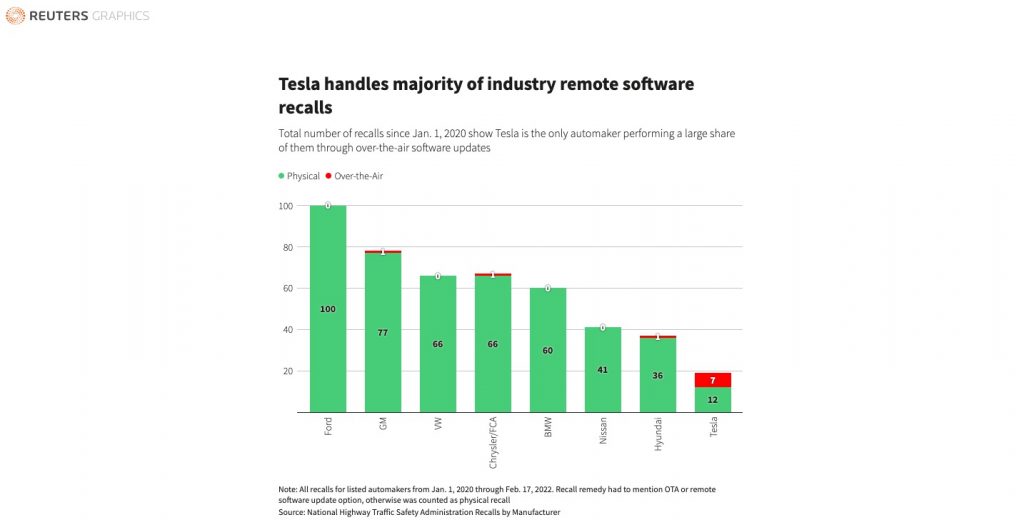It is no secret that Tesla is a popular topic, so much so that the coverage around the company is immense. Couple this with CEO Elon Musk’s rockstar persona and you get a company whose vehicles are looked at under a microscope constantly. It might feel unfair for some, but it’s just the way it is. Tesla — by simply being Tesla — is newsworthy.
Tesla’s newsworthiness is a double-edged sword. A look at the coverage for the company’s vehicle recalls from the NHTSA would prove this point. So notable is Tesla’s news coverage that a mainstream newsreader would likely get the impression that Teslas get recalls frequently. The opposite is true. As evidenced by Reuters in the graphic below, data from January 1, 2020, through February 17, 2022, shows that Tesla actually recalls its vehicles less frequently than some of the market’s leading automakers. Tesla is also the only carmaker performing a large share of its vehicle recalls through over-the-air software updates.

Tesla currently handles the majority of the industry’s remote software recalls, but it would soon not be the only one. New electric vehicle makers have used the idea of software updates as a means to promote their EVs’ capabilities. Rivian has performed OTA updates to its R1 vehicles, and those cars are only starting customer deliveries. Lucid is the same with its Air sedan, with the company rolling out features like Automatic Emergency Braking, Cross-Traffic Protection, Lane Departure Protection, Traffic Drive-Off Alert, and other features earlier this month through a software update. Ford has been rolling out updates called “Power-Ups” to the Mustang Mach-E as well.
Considering that software-based fixes are only bound to get more widespread over the coming years, one must then ask the question: Should software-based over-the-air fixes be dubbed and classified with the same terminologies as physical recalls, which typically involve the replacement of vehicle hardware?
A Vastly Different “Recall” Experience
Any car owner has likely experienced a recall for their vehicle at some point in their driving life. And more likely than not, one’s experience is probably not that pleasant. I certainly count myself among drivers who look at vehicle recalls with trepidation. My current vehicle, a Japanese-made van, was part of a minor fuel pump recall a couple of years ago, and even addressing that took a whole day out of my weekend. The dealer was overwhelmed with the number of cars it was fixing that day, and tempers among owners were flaring by the hour — all for a simple fuel pump replacement. I’ve been told that my experiences with vehicle recalls are not that unique.
In comparison, a software-based fix, such as the disabling of FSD Beta’s “rolling stops” feature, only required affected vehicles to be connected to the internet. There was no dealer visit, no forms to fill out, and no staff to argue with. The car was connected to the internet, a software fix was implemented, and the issue was resolved. One can argue that Tesla’s software fix to disable FSD Beta’s “rolling stops” feature was safety-related, and that’s true. But one could also argue that at least from a driver’s point of view, the experience related to software and hardware-based recalls is vastly different.
The Status Quo
Despite the different experiences involved when software and hardware-based vehicle recalls are addressed, it appears that the National Highway Traffic Safety Administration (NHTSA) will, at least for now, keep the status quo. Teslarati reached out to the NHTSA to inquire if it was considering the adoption of updated terminologies for cars whose fixes are completed through OTA software updates, but the agency suggested that this would likely not be the case, at least for now. According to the NHTSA, vehicle manufacturers must initiate a recall for any repair that remedies a safety risk, regardless of whether the issue is fixed by software update or by hardware replacement.
“The National Highway Traffic Safety Administration is committed to ensuring the highest safety standards on the nation’s roadways. NHTSA is empowered with robust tools and authorities to protect the public, to investigate potential safety issues, and to compel recalls when it finds evidence of noncompliance or an unreasonable risk to safety. Manufacturers are required to initiate a recall for any repair, including a software update, that remedies an unreasonable risk to safety. NHTSA recalls can include any required repair, which includes a software update, to remedy a potential safety risk. Manufacturers are also required to submit any communications to owners, dealers, and others about any software updates that address a defect, whether it is safety-related or not,” the NHTSA stated.
Product recall specialist and associate professor at the Indiana University Kelley School of Business Professor George Ball told Teslarati that while the NHTSA’s use of similar terminologies for software and hardware-based recalls is “definitely an example of regulators and industry moving at a different pace on technology,” the agency’s hesitation in adopting new terminologies for OTA fixes is understandable. Professor Ball further explained that using terms such as “soft recall” to refer to software-based vehicle fixes might imply a reduced level of risk, and this is something that the NHTSA would likely be unwilling to do.
“I believe NHTSA would resist ‘soft recall’ terminology because it implies a reduced level of customer hazard and allows the firm to be under less scrutiny by the press and public for quality corrections. While some updates are minor, some of the Tesla software upgrades are actually quite serious, and if not done, can allow a harmful defect to persist,” the recall specialist said.
But while the NHTSA’s stance on recall terminologies is completely understandable, one cannot deny the fact that the issues covered by vehicle recalls have a very wide range of risks. Take Tesla’s recall for 817,143 vehicles, which was announced earlier this month, for example. The recall was initiated since a software error may prevent a warning chime from activating even if drivers do not have their seat belts on. From a layman’s perspective, this recall seems grave as it affects over 800,000 Teslas on the road today. However, the issue was simply addressed through firmware release 2021.43.101.1 and later, which included a remedy for the seat belt chime error.
Compare this with General Motors’ recall last year of 400,000 pickup trucks in the US. Granted, it only affected about half as many vehicles as Tesla’s seat belt chime recall, but its hardware-based nature suggested that the risk presented by the issue was great. The recall covered certain 2015 and 2016 Chevrolet and GMC Sierra 1500, 2500, and 3500 trucks, and it involved a faulty airbag inflator that may rupture without warning. To fix the issue, owners of the affected trucks were required to head to a dealer so that they could get their airbag modules replaced. Since parts were in short supply last year, however, owners were notified with a letter to inform them when their trucks’ replacement parts were available.
What Can Be Done
While the NHTSA will likely continue to maintain the status quo with its recall terminologies for the foreseeable future, Professor Ball told Teslarati that the agency can actually implement some adjustments now that can make distinguishing safety fixes and issues clearer. This would likely be extremely important in the near future as more connected cars are rolled out and software updates become the norm.
“If I were to provide advice to the NHTSA, I would recommend that they get out ahead of this issue before every car maker starts updating cars like Tesla. One way to do it is to require the automaker to send all auto updates to NHTSA when pushed out, and to classify updates as ‘minor’ or ‘major.’ Any major update that impacts customer safety would be classified as a recall. Automakers won’t like this, but it will help keep the safety fixes transparent for all, especially consumers. By sending all updates to NHSTA, the agency could assign qualified people to audit the classifications assigned by the manufacturer, to ensure they are making good decisions there.
“I think any language that de-emphasizes the importance of a safety recall is not likely to be supported by NHTSA, and it doesn’t likely help customer safety. A clear distinction needs to be made between minor updates and major updates that influence safety. Those major updates should be classified as a recall, and NHTSA needs to get their arms around these updates and keep on top of them soon, or they will fall way behind the industry,” the recall specialist said.
Recalls can affect the perception of a company to the public. Software fixes should be one of the factors that are considered an edge for automakers like Tesla, not the other way around. Gary Black, Managing Partner of The Future Fund LLC, explained this from the point of view of a Tesla investor. “Since every NHTSA recall so far has been quickly solvable via Tesla OTA updates, ‘recalls’ are noise to most investors. Tesla’s huge software edge highlights one of the key advantages of owning Tesla over every other EV manufacturer,” the Wall Street veteran told Teslarati.
OTA updates, including those related to vehicle safety, are coming. With automakers like Ford joining the group of carmakers embracing OTA updates, software-based fixes are inevitable. Ultimately, I am inclined to agree with the recall specialist. By refusing to adapt to the advent of software-based vehicle fixes, the NHTSA may risk being left behind by the automotive industry. And that’s a scenario that I believe no automaker — or government agency for that matter — would prefer.
Don’t hesitate to contact us with news tips. Just send a message to simon@teslarati.com to give us a heads up.











